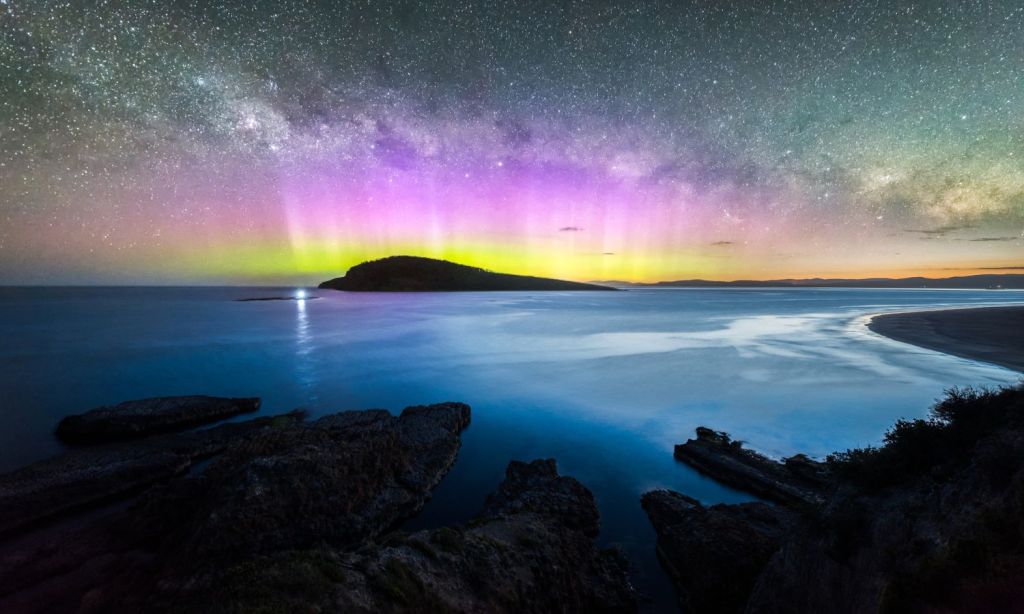The southern lights, also known as aurora borealis, have long been one of the southern hemisphere’s most magnificent light shows. But with more of our travel now documented on social media, bearing witness to the natural phenomenon, which sees the night sky flicker with shades of green, blue, purple and red, has boomed in popularity.
If you’re among those keen to catch this special light show, read on for all the details on it below. From when and how often it occurs, to the best places to catch it, this is your complete guide to glimpsing the southern lights in Australia.

Which Country Has the Southern Lights?
Lucky for us, Australia, particularly the island of Tasmania, is generally considered one of the best places to see the southern lights. You can also view them in New Zealand, with Mt. John Observatory one of the best spots, the Falkland Islands in the UK and Ushuaia in Argentina. Although the trickiest to get to, Antarctica is easily the best viewing spot, with its untouched natural landscapes, snow-white icebergs and little-to-no pollution.
What Causes the Southern Lights?
The lights we see in the night sky are caused by activity on the surface of the sun, explains Royal Museums Greenwich. Solar storms on our star’s surface give out huge clouds of electrically charged particles. These particles can travel millions of miles, and some may eventually collide with the Earth.
While most of these particles are deflected away, some become captured in the Earth’s magnetic field and accelerate down towards the north and south poles into the atmosphere.

“These particles then slam into atoms and molecules in the Earth’s atmosphere and essentially heat them up,” says Royal Observatory astronomer Tom Kerss. “We call this physical process ‘excitation’, but it’s very much like heating a gas and making it glow.”
The lights we see are atoms and molecules in our atmosphere colliding with particles from the sun. The wavy patterns are caused by the lines of force in the Earth’s magnetic field.
What Is the Difference Between Northern Lights and Southern Lights?
In the north, the light show is called the aurora borealis or northern lights. In the south, it’s the aurora australis or southern lights.
Though the Earth’s magnetic field stretches symmetrically from the north to the south, meaning the northern and southern lights should look the same, satellite images of the entire planet have shown mismatched auroras happening at the same time in the two hemispheres.
It’s also been said that though the northern and southern lights both appear as curtains, arcs or swirling light patterns, the colours visible vary slightly. The northern lights are usually green and white, though red, purple, pink and blue hues can also be seen. In the south, the lights tend to be green and pink, but red, purple and blue can also be visible.
When Can You See the Southern Lights in Australia?
Like the northern lights, the southern lights happen all year round, though certain times of the year allow for better visibility. They’re most seen in the colder months, May to August, and during the spring equinox in September. It’s best to view or photograph the lights on clear, dark nights in a place with little-to-no pollution. For your best chance to spot the lights, keep up-to-date with local weather reports and join Facebook groups dedicated to sighting the southern lights.
Where Is the Best Place in Australia to See the Southern Lights?
To see the southern lights in Australia, you want to get as close within the country to the southern magnetic pole, so Tasmania. While you have a chance of seeing the lights anywhere within the state, Bruny Island and Satellite Island are two of the most popular viewing places, as they’re both away from city life and so less polluted. Bruny Island is a 30-minute drive from Hobart, while Satellite Island is an islet off the coast of Bruny.
The southern lights can also be seen in Hobart, with your best chance from the city’s highest peaks, like Mount Wellington. They can also be spotted in Cradle Mountain-Lake St Clair National Park, Mount Nelson and Bathurst Harbour in the Tasmanian Wilderness World Heritage Area.
The southern lights can also be seen from Victoria. Point Lonsdale, Aireys Inlet, Anglesea and the south side of Philip Island are good options, though Wilsons Promontory is one of the best viewing spots in the state.
Some areas of southern New South Wales and the southernmost parts of South Australia and Western Australia occasionally are treated to the lights, too.
Related: The Latest Travel Trend Takes Its Cue From ‘The Holiday’
Related: The Most Common Travel Scams to Watch Out For in 2024
Read more stories from The Latch and subscribe to our email newsletter.







